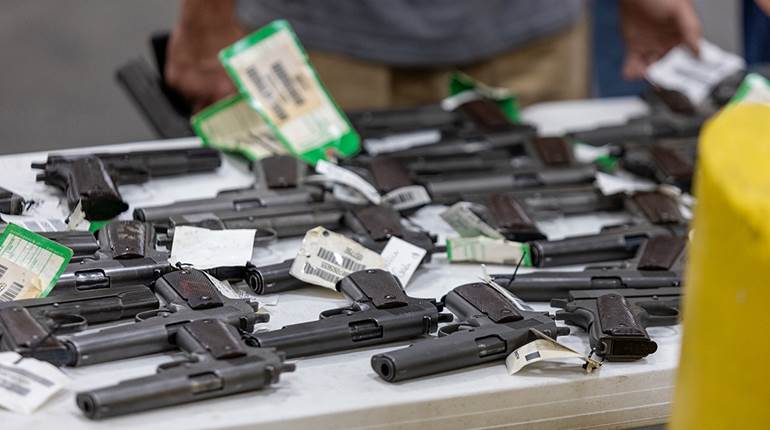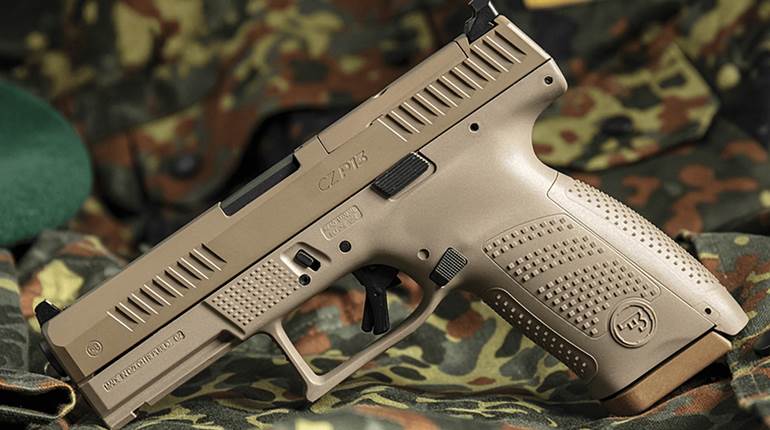Of the U.S. airborne forces to partake in the overall operations during the Allied landings in Normandy on June 6, 1944, the 82nd Airborne Division played an important role. The operation that would ferry the 82nd Airborne into Normandy was code named "Mission Boston", transporting 6,420 men through the use of 370 C-47 transport aircraft and gliders. Similar to the objectives of the 101st Airborne Division, the 82nd Airborne was tasked with two main goals, to capture the city of Sainte-Mère-Église and several river crossings in the area behind Utah Beach.
 A C-47 "Skytrain" transport aircraft with white and black bands painted on to help distinguish Allied aircraft during the D-Day landings.
A C-47 "Skytrain" transport aircraft with white and black bands painted on to help distinguish Allied aircraft during the D-Day landings.
The 82nd Division had originally formed during World War I in 1917, and was the same division that Sgt. Alvin York served with. Since many of the servicemen in the initial 82nd Infantry Division had come from all across the United States, it earned the nickname of the "All-American" division, which became the basis for its famous "AA" marked shoulder patch. In 1942, the 82nd Infantry Division was reshaped into the first U.S. airborne division.
 Paratroopers of the 82nd Airborne Division.
Paratroopers of the 82nd Airborne Division.
The men of the airborne divisions differed from the normal infantry units in both purpose and mentality. All were volunteers, and the practice of parachuting into combat from aircraft was especially dangerous and still relatively new to warfare. They also were trained with special skill sets not typical for the normal infantry, focusing on operations behind enemy lines where being surrounded without support was expected.
 The front of the Sainte-Mère-Église church as seen today.
The front of the Sainte-Mère-Église church as seen today.
Like the 101st Airborne, the C-47s carrying the 82nd Airborne arrived over their drop zones in Normandy in the early morning hours of June 6. They also experienced the same issues, as aircraft spread out and paratroopers were dropped away from the planned drop zones. At 1 a.m., one C-47 carrying men of the 82nd Airborne flew directly over downtown Sainte-Mère-Église when the green light to jump turned on. In the darkness, the men parachuted down into the city.
 A photo of Sgt. John Ray.
A photo of Sgt. John Ray.
These men were from the mortar section of "F" Company, 505th Parachute Infantry Regiment, and were dropped a mile off from where they were supposed to be. Instead, they came down into the German-occupied city. One of the men to land in the city was Sgt. John Ray, who hit the ground right in front of the doors of the Sainte-Mère-Église church, and was injured upon impact. As Sgt. Ray was trying to work himself free from his parachute harness, a German soldier came around the corner of the church and shot him with a Karabiner 98k in the stomach.
 A re-enactor dressed as a World War II German rifleman armed with a Karabiner 98k.
A re-enactor dressed as a World War II German rifleman armed with a Karabiner 98k.
The shot dropped Sgt. Ray to the ground, but he was still alive. The German soldier then walked past the stricken Sgt. Ray and spotted another paratrooper, Pvt. Ken Russell, hanging from the roof of the church by his chute. As the German took aim at Pvt. Russell with his rifle, Sgt. Ray drew his M1911A1 service pistol and emptied its magazine into the back of the German who shot him, ultimately saving his helpless comrade's life. Sgt. Ray managed to stay alive for another week, despite his wound, before succumbing to gangrene.
 A re-enactor dressed as a World War II U.S. infantryman armed with a M1911A1 service pistol.
A re-enactor dressed as a World War II U.S. infantryman armed with a M1911A1 service pistol.
Another member of the 82nd Airborne to show incredible courage in the face of the enemy during the invasion was Pvt. Joe Gandara of "D" Company, 507th Parachute Infantry Regiment. He was a machine gunner, operating the M1919A4 .30-cal. belt-fed machine gun. During the afternoon of June 9, Pvt. Gandara was a part of an assault on German positions near Amfreville. During the fight, Pvt. Gandara lifted his M1919A4 off of its mount and, with the barrel shroud slung over his forearm, charged a German machine gun position head on while firing his own from the hip.
 Firing a U.S. M1919A4 .30-cal. belt-fed machine gun.
Firing a U.S. M1919A4 .30-cal. belt-fed machine gun.
Pvt. Gandara managed to make his way up to the machine gun nest and silence its occupants, before becoming the victim of a German rifleman just a short time later. For his heroism, Pvt. Gandara was posthumously awarded the Distinguished Service Cross, an honor that was celebrated by his family. In 2015, Pvt. Gandara's award for his selfless act was upgraded, fittingly, to the Medal of Honor.
 A memorial for Pvt. Joe Gandara, near where he performed his heroic act, as seen today.
A memorial for Pvt. Joe Gandara, near where he performed his heroic act, as seen today.
During the Normandy invasions the Germans were caught off guard, stuck in a defensive situation. They had some level of preparation for an anphibious landing, with the construction of Hitler's "Atlantic Wall," but the concentration of German defensive forces had been sent to Pas-de-Calais further northeast. Despite being under-manned, the German defenders still had lethal defensive capability through their general-purpose machine guns. Unlike Allied infantry units that derived their firepower through massed riflemen, the machine gun formed the backbone of the German infantry.
 A re-enactor dressed as a World War II German infantryman firing a MG42 on a tripod mount.
A re-enactor dressed as a World War II German infantryman firing a MG42 on a tripod mount.
Their machine guns were arguably the best in use at the time, the MG34 and the dreaded MG42, both chambered in 7.92x57 mm Mauser. The MG42 specifically gave the German infantry a massive advantage in defensive capability, with its 1,200 r.p.m. fire rate and quick-change barrel. Spare barrels and ammunition were also carried by the supporting infantry, with the German rifleman's main objective being to defend and support the machine gun crew.
 A photo of PFC Charles N. DeGlopper.
A photo of PFC Charles N. DeGlopper.
Another act of heroism from a member of the 82nd Airborne in Normandy also happened on June 9, near Manche. That morning, a squad from "C" Company, 325th Glider Infantry Regiment was maneuvering through hedgerows and down a road when they went into a field through a gate. As the squad went into a field, a German machine gun positioned in a nearby building opened fire onto the group. They were immediately pinned down, and their route of escape was cut off by the machine gun's field of fire.
 A view of the field where the squad was pinned down, the building from which the German machine gun was firing and the spot in the road where PFC DeGlopper made his stand, as seen today.
A view of the field where the squad was pinned down, the building from which the German machine gun was firing and the spot in the road where PFC DeGlopper made his stand, as seen today.
The situation seemed hopeless, until one of the men, PFC. Charles N. DeGlopper, stood up with his M1918A2 Browning Automatic Rifle. PFC DeGlopper began to return fire at the German machine gun position while standing in the middle of the street, completely exposed. As he suppressed the German position, his comrades who had been pinned down in the field managed to fall back to safety. When Pvt. DeGlopper was changing magazines, he was struck by a bullet and fell.
 A memorial commemorating PFC DeGlopper near where he made his heroic stand, as seen today.
A memorial commemorating PFC DeGlopper near where he made his heroic stand, as seen today.
However, PFC DeGlopper then managed to stand back up and continued firing as the rest of his squad fell back. He held his ground even after the squad was out of harm's way, just in case anyone was still stuck in the field. As he was changing to a third magazine, PFC DeGlopper was hit again and fell into the street dead. His sacrifice ultimately saved the lives of all his squad mates, for which he was posthumously awarded the Medal of Honor. He was the only member of the 82nd Airborne to be honored with the award during the battle for Normandy, until Pvt. Gandara's award was upgraded in 2015.
To watch complete segments of past episodes of American Rifleman TV, go to americanrifleman.org/artv. For all-new episodes of ARTV, tune in Wednesday nights to Outdoor Channel 8:30 p.m. and 11:30 p.m. EST.
























